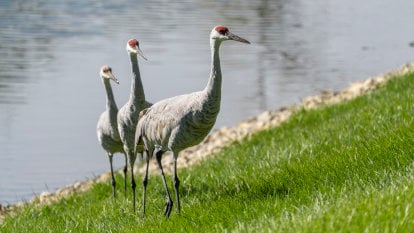Sandhill Crane Migration in Illinois 2026
Sandhill cranes make a stop at northern Illinois marshes on their way to Florida
Best time: mid-September–mid-November
Sandhill crane or Antigone canadensis is one of the oldest birds on the planet and one of the most prominent in North America, thanks to its large size and a recognizable red spot on the forehead. Luckily, these birds can be spotted almost everywhere throughout the Midwest, especially during their annual migration season.
Migrating Season
From mid-September to mid-November, thousands of cranes from the eastern population migrate through Illinois on their way to wintering sites in Florida. Additionally, a small population of cranes remains in northeastern Illinois during spring and summer for breeding and nesting.
Where Can You See Sandhill Cranes?
Cranes thrive in shallow waters and open spaces, making prairies, wetlands, and marshes their preferred habitats. During migration, they often stop in crop fields and marshy areas to rest and feed. A small number now breed in Illinois, particularly in Lake and McHenry counties.
For spotting sandhill cranes in Illinois, Moraine Hills State Park and Goose Lake Conservation Area in McHenry County are excellent choices. Other great locations include Chain of Lakes State Park, Rollins Savanna Forest Preserve, and Volo Bog in Lake County. However, the best spot in the region is the Jasper-Pulaski Fish and Wildlife Area in Indiana, just a two-hour drive from Chicago.
Migratory Madness Evening
Every fall, from September through November, the McHenry County Conservation District hosts the "Migratory Madness Evening" at Lost Valley Visitor Center in Glacial Park. The event, which runs from 5:30 pm to 8 pm, offers the chance to observe sandhill cranes gathering just below the windows of the Lost Valley Overlook Room. The experience also includes an educational presentation about the biology and behavior of these birds, along with dinner. Admission is free for residents, while non-residents are charged $5. the McHenry County Conservation District also hosts various events like Accessible Seed Collection Day, Chainsaw Training, Cycling, fun family events like Fall Family Scavenger Hunt, Halloween events, etc.
Sandhill Crane Info
Renowned for its courtship dance, the Sandhill Crane is one of North America's largest migratory cranes, with a wingspan that can reach nearly seven feet and a height of up to four feet. Its impressive wingspan allows it to soar gracefully, using thermal currents to glide with minimal flapping. The Sandhill Crane is an ancient species, with fossil evidence dating back 2.5 million years—significantly older than most bird species still in existence today. Worldwide, the sandhill crane populations are estimated to be about 500,000 in number. Of those, around 400,000 live in North America.
Endangered Species
Last year, crane counters in northern Illinois recorded 478 sandhill cranes and three whooping cranes, a remarkable recovery considering their near-extinction. Before European expansion, both species thrived across North America's prairies and wetlands, but by the 1940s, only 20 whooping cranes remained, and sandhill cranes were nearly wiped out from the Midwest. This decline was due to unregulated hunting, feather and egg collecting, and massive habitat loss, with over 90% of Illinois' wetlands destroyed. Thanks to laws protecting wild spaces and restoration efforts, both crane populations have rebounded. Sandhill cranes have also adapted to human-dominated landscapes, further aiding their recovery.
Sandhill Crane Migration Map
Regardless of the season, it's always better to track Sandhill Cranes by using migration maps such as eBird.















































































